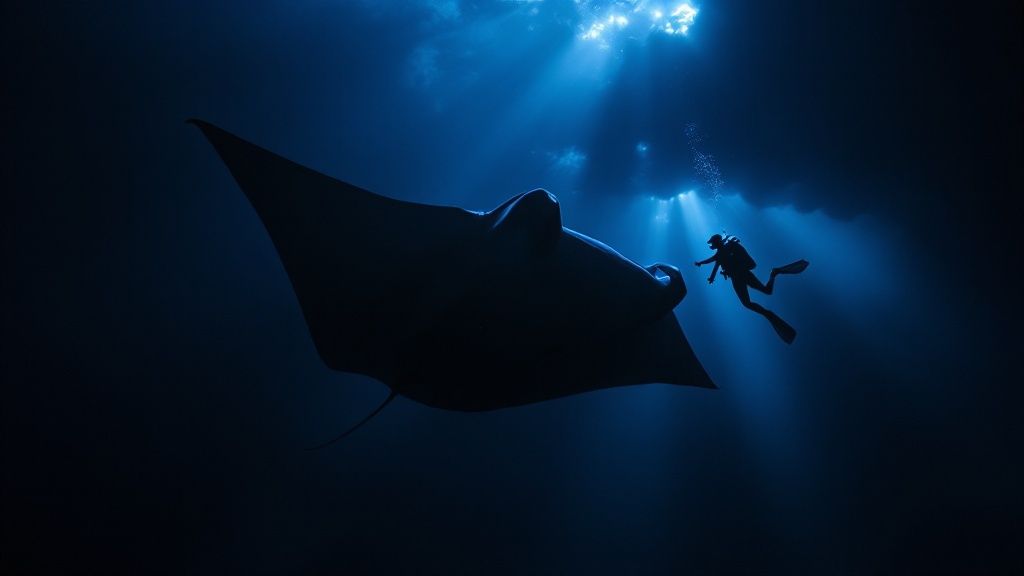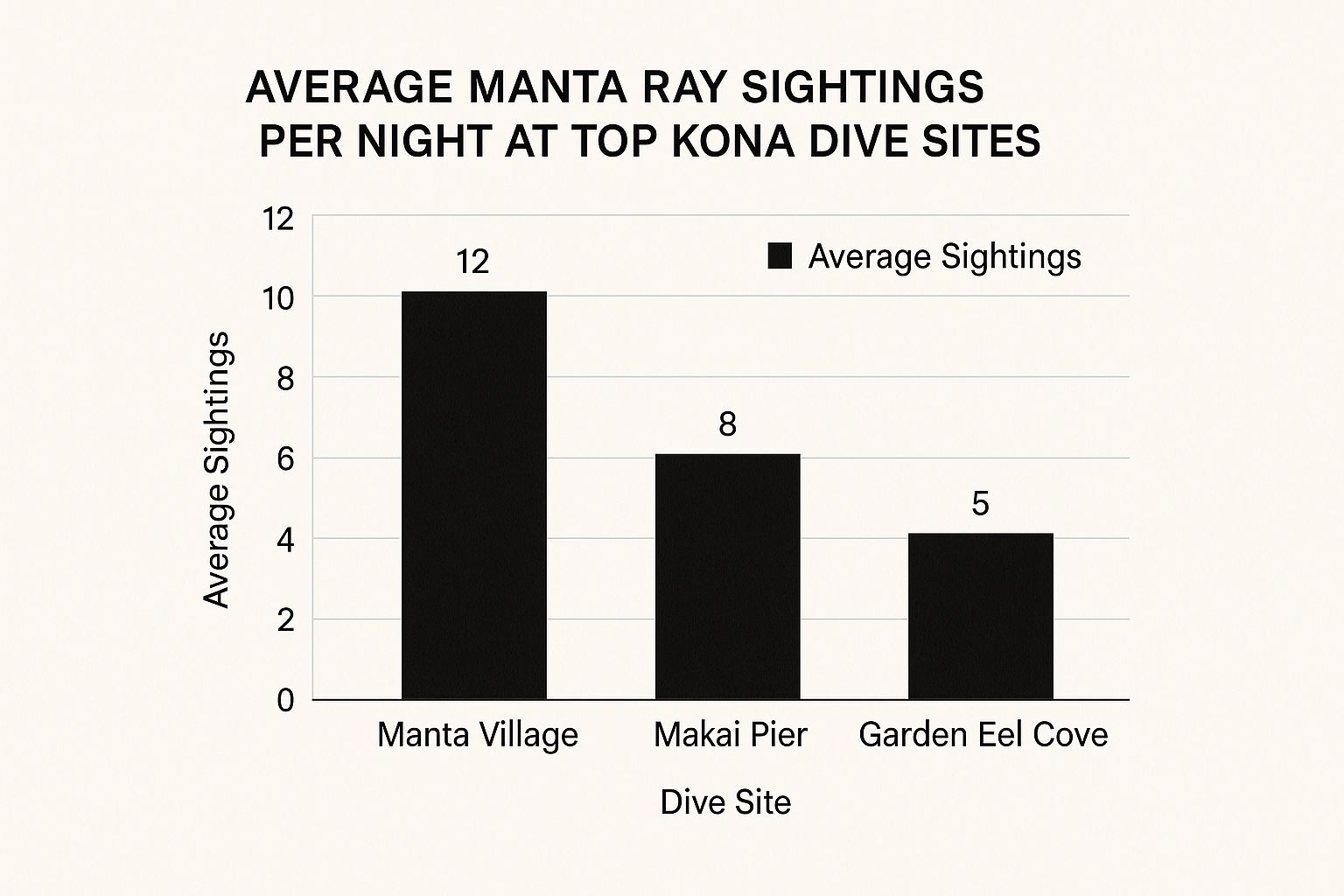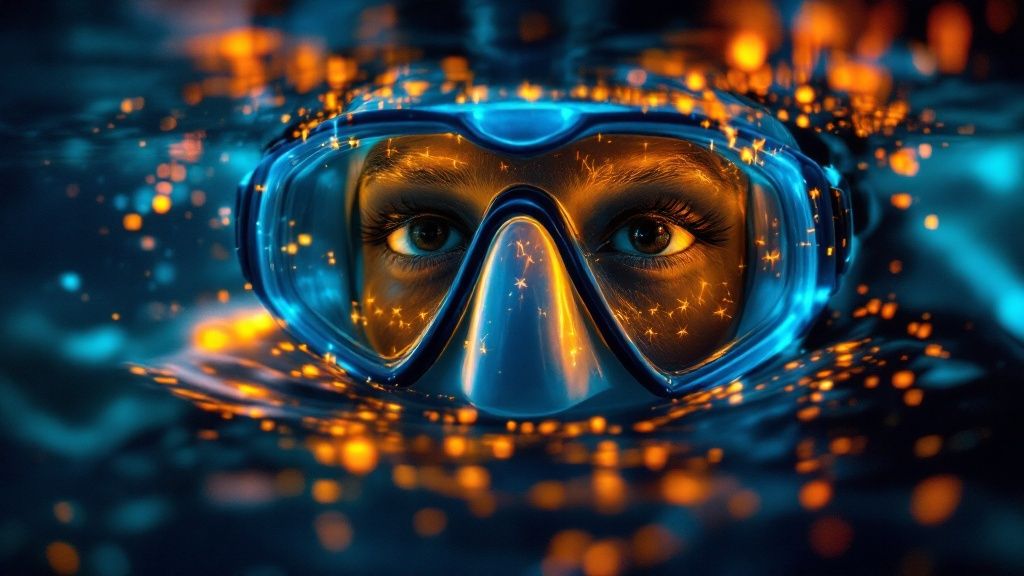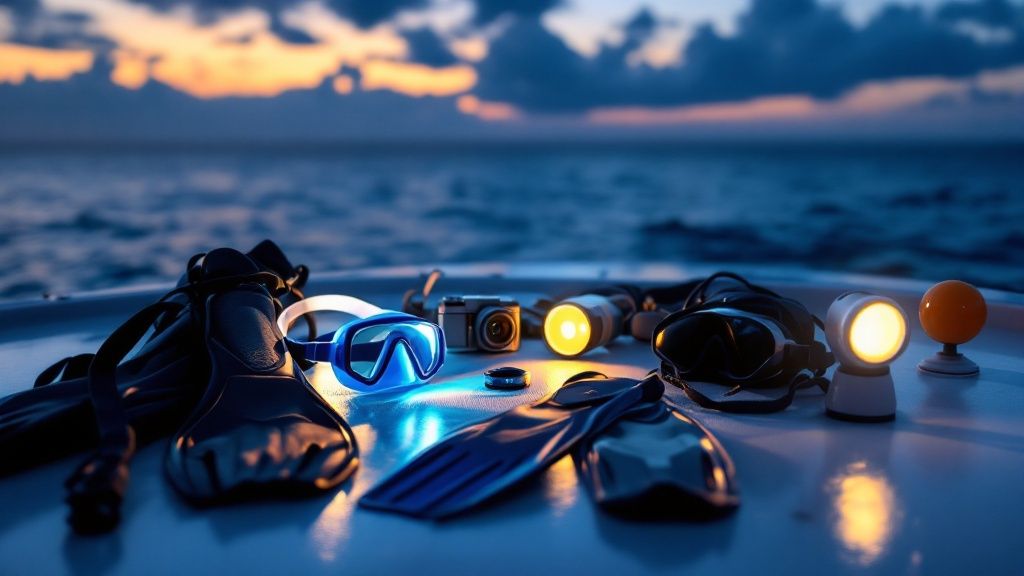The Magic of Manta Ray Night Dives in Kona
Imagine floating in the dark depths of the Pacific, the only light coming from the gentle glow of underwater lamps. Then, a majestic manta ray appears, its wingspan unbelievably large. This is the magic of a manta ray night dive in Kona, an experience consistently ranked as one of Hawaii's most memorable underwater adventures.
These nighttime excursions are truly special. The feeling of swimming alongside these gentle giants is surreal. Kona's unique environment provides a consistent haven for manta ray encounters. Divers settle on the ocean floor with specialized dive lights, creating a "campfire effect." This attracts plankton, the manta ray's main food source, and initiates a captivating feeding display. Curious to learn more? Check out this helpful resource: How to master the manta ray night dive.
The Kona Coast: A Manta Ray Hotspot
The Kona Coast has long been famous for its regular manta ray sightings. From 2009 to 2014, researchers carefully documented these sightings at spots like 'Manta Village' and 'Manta Heaven', monitoring individual mantas and their health. This work significantly expanded our knowledge of manta ray behavior and movements. The success of this research, which involved night dives six to seven times a week, is reflected in the approximately 80,000 tourists who join manta ray snorkeling or diving trips every year. More detailed statistics are available here. This dedicated research underscores Kona's importance for manta ray observation and protection.
The Ballet of Lights and Plankton
The interplay of light, plankton, and manta rays is a truly unique natural spectacle. Drawn in by the plankton gathered around the divers' lights, the mantas execute elegant loops and barrel rolls, using their cephalic fins to guide the tiny creatures into their mouths. This creates a mesmerizing underwater dance, leaving even seasoned divers in awe.

Capturing the Magic: Photography and Souvenirs
Want to capture the magic of your dive? Consider documenting your experience with photos and videos. For a creative souvenir, explore AI-powered shirt design options. Tshirt Design AI can offer some inspiring ideas. These tangible mementos allow you to share the wonder of this incredible encounter.
Insider's Guide to Kona's Premier Manta Ray Dive Sites
Navigating Kona's coastline for the perfect manta ray dive can feel overwhelming with the sheer number of options. This guide goes beyond the typical tourist pamphlets to uncover what makes some sites truly special. We'll explore the unique characteristics that draw mantas to these locations night after night.
Manta Village (Keauhou Bay): The Classic Choice
Keauhou Bay, affectionately called Manta Village, is famous for its consistent manta ray sightings. The bay's shallow, sandy bottom provides the perfect setting for the "campfire effect" employed by dive operators. Divers kneel on the seabed with powerful dive lights angled upwards, attracting plankton, which in turn, brings in these gentle giants. This location is usually calm and easily accessible, making it perfect for divers of all skill levels.
Manta Heaven (Garden Eel Cove): A Deeper Experience
Looking for something a bit different? Consider Manta Heaven at Garden Eel Cove. This site can have stronger currents, but the payoff is often more dynamic manta ray interactions. The deeper water here attracts larger quantities of plankton, creating spectacular feeding displays. This location offers a more adventurous dive for those comfortable with slightly more challenging conditions.
Makai Pier: A Hidden Gem
A lesser-known, but equally rewarding option, is the Makai Pier. This site often has smaller crowds, allowing for a more personal manta ray encounter. The pier's structure creates a fascinating underwater landscape, providing unique photo opportunities for underwater photographers. The infographic below shows the average number of manta ray sightings per night at these Kona dive sites.

As the data shows, Manta Village has the highest average sightings, followed by Makai Pier and then Garden Eel Cove. However, the lower numbers at Garden Eel Cove and Makai Pier often result in a more intimate experience. You might also be interested in learning how Kona Honu Divers Was Voted Best Dive Operator.
Choosing the Right Site For You
The best site for you depends on your experience level and what you're looking for in a dive. Manta Village is perfect for beginners, while seasoned divers may prefer the excitement of Manta Heaven or the peaceful atmosphere of Makai Pier.
To help you further in your decision-making process, take a look at the comparison table below:
Kona Manta Ray Dive Sites Comparison: A comprehensive comparison of the main manta ray dive sites in Kona, including success rates, average number of mantas, access difficulty, and best times to visit.
| Site Name | Success Rate | Avg. Mantas Per Dive | Water Conditions | Best Time to Visit | Crowd Level |
|---|---|---|---|---|---|
| Manta Village (Keauhou Bay) | 80-90% | 10-15 | Calm, shallow | Year-round | High |
| Manta Heaven (Garden Eel Cove) | 80-90% | 5-10 | Can be choppy, deeper | Year-round | Medium |
| Makai Pier | 80-90% | 7-12 | Variable, moderate depth | Year-round | Low |
This table highlights the key differences between the sites, allowing you to easily compare and choose the best fit for your dive experience.
Manta rays in Kona are carefully tracked by researchers and tour operators who identify them by their unique belly patterns. Over 290 individual manta rays have been cataloged, with "Lefty" being the very first one identified. The nutrient-rich currents often cause plankton blooms, which attract large numbers of mantas. In 2013, monthly sightings per dive location varied from 50 to 150, resulting in an impressive 80-90% success rate throughout the year. This data collection allows researchers from organizations like SciStarter to continuously monitor manta ray behavior and ecosystem health. Understanding the subtle differences of each location helps ensure an unforgettable manta ray diving experience in Kona.
Mastering Your Manta Ray Dive Experience
Transforming your manta ray night dive in Kona from just good to truly extraordinary depends on preparation. This involves carefully considering several key factors, from selecting the right tour operator to understanding the nuances of manta ray behavior. By mastering these elements, you'll be well-prepared for an incredible, unforgettable encounter.
Choosing the Right Tour Operator for Your Manta Ray Dive Kona
Selecting the right tour operator is essential for a successful manta ray dive in Kona. For new divers, look for operators that emphasize safety and provide comprehensive pre-dive briefings. Experienced divers might prefer smaller groups and operators who cater to underwater photographers. Some even offer specialized lighting equipment or advanced dive profiles. Learn more in our article about what it's like to go on a manta ray dive in Kona, Hawaii.
Boat size and amenities are also important considerations. A spacious dive deck with easy water entry and exit can greatly improve your comfort, especially after a night dive. Finally, don't underestimate the value of experienced dive masters. Their knowledge and passion for these magnificent creatures can truly enrich your experience.
To help you choose, we've compiled a table comparing several top-rated Kona manta ray dive tour operators:
Manta Ray Dive Kona Tour Operators: An overview of the top-rated manta ray dive operators in Kona with their offerings, pricing, group sizes, and special features.
| Tour Operator | Experience Type | Group Size | Price Range | Equipment Provided | Special Features | Reviews Rating |
|---|---|---|---|---|---|---|
| Big Island Divers | Beginner to Advanced | 6-12 | $150-$200 | Tanks, Weights, Lights | Underwater Photography Assistance | 4.8 stars |
| Kona Honu Divers | Beginner to Advanced | 4-8 | $175-$225 | All Dive Gear | Small Group Experience | 4.9 stars |
| Manta Adventures | All Levels | 10-16 | $160-$210 | Tanks, Weights, Lights | Hydrophones for Manta Sounds | 4.7 stars |
| Dive With Manta | Experienced Divers | 4-6 | $190-$250 | Full Gear, Cameras Available for Rent | Advanced Dive Profiles, Nitrox Available | 4.6 stars |
This table highlights the diverse offerings available, from small group experiences to specialized photography assistance. Be sure to choose the operator that best suits your skill level and interests.
Gear Up for Success: Essential Equipment for Kona's Waters
The proper gear can significantly improve your manta ray dive. A 3mm wetsuit is typically sufficient in Kona, but if you tend to get cold, a 5mm might be a better choice. Hawaiian waters, while warm, can feel cool at night, especially during deeper dives.
Proper lighting is essential for attracting plankton, the manta rays' primary food source, and observing the mantas. Most operators provide dive lights. If you bring your own, make sure they are manta-friendly. Avoid bright flashes or strobes that can disturb the animals. Red-filtered lights are a good option as they are less disruptive to marine life.

Mastering Underwater Etiquette: Respecting the Mantas
Maintaining proper buoyancy control is vital once in the water. Avoid touching the coral or the mantas. This protects the fragile ecosystem and ensures a more natural and respectful interaction.
Position yourself patiently near the bottom without disturbing the seabed, allowing the mantas to come to you. Resist the urge to make sudden movements or chase them. This patient approach will create more intimate and prolonged encounters. When the mantas feel comfortable, they are more likely to display their natural feeding behaviors. Understanding these nuances transforms your dive from mere observation into a truly shared experience.
The Secret Lives of Kona's Gentle Giants
Manta ray dives in Kona offer a unique opportunity to connect with these intelligent creatures. It's more than just a dive; it's a chance to witness their graceful movements and learn about their fascinating biology and behavior. By understanding Kona's reef mantas, you'll gain a deeper appreciation for this incredible experience. For more reasons to dive with manta rays in Kona, check out this article.
Evolutionary Wonders: A Legacy in Motion
Manta rays have graced our oceans for over 20 million years. Their distinctive cephalic fins, which resemble horns, help them funnel plankton into their mouths. Their size, too, is a key factor in their survival. While the largest manta ray ever recorded measured an incredible 22 feet (7 meters) wide, the reef mantas found in Hawaii typically range from 12 to 14 feet (3 to 5 meters).
Despite their impressive size, manta rays are gentle giants. The nutrient-rich waters off the Kona Coast provide an ideal habitat, teeming with the plankton they depend on. This makes Kona a hotspot for manta ray sightings, attracting tourists and researchers alike. An estimated 80,000 people participate in manta ray snorkeling tours each year, demonstrating Kona’s importance in global manta ray tourism. To learn some interesting facts about manta rays, click here. Their continued presence in our oceans speaks volumes about their adaptability and resilience.
Decoding Manta Behavior: Barrel Rolls and Social Structures
Manta rays boast the largest brain-to-body ratio of any fish. They display complex social structures and utilize intricate communication methods, including subtle body language and cooperative feeding strategies. Their signature barrel rolls, for example, are not just visually stunning but serve a practical purpose: filtering plankton from the water. This behavior allows them to maximize their nutrient intake within Kona's plankton-rich currents, showcasing their remarkable cognitive abilities.
The Importance of Gill Structure and Plankton
As filter feeders, manta rays depend on their specialized gill structures. These gills efficiently capture microscopic plankton from the water, a crucial aspect of their survival in Kona's nutrient-rich environment. Understanding this essential biological function helps us appreciate the vital role manta rays play in the marine ecosystem.
Beyond Tourism: Protecting Kona's Manta Ray Legacy
Your manta ray dive in Kona isn't just a thrilling personal experience. It's a vital part of ongoing conservation efforts, ensuring these magnificent creatures thrive for generations to come. Every diver plays a role in safeguarding the future of these gentle giants.
Challenges Facing Kona's Manta Rays
Hawaii's manta ray population faces numerous challenges. Increasing ocean temperatures and microplastic pollution pose significant threats. Even tourism, while vital for the local economy, presents a complex dilemma. Irresponsible tourism practices can disrupt manta ray feeding and harm their fragile habitat. This highlights the importance of selecting responsible tour operators who prioritize manta ray well-being.
Responsible Dive Operators: Making a Difference
Many Kona operators are actively involved in conservation, recognizing that preserving the manta ray population is crucial for their businesses' long-term sustainability. These operators implement sustainable practices like adhering to strict viewing guidelines, limiting group sizes, and educating divers on proper manta ray interaction. When booking your Kona manta ray dive, seek out operators who actively support these initiatives. You might be interested in: Kona Honu Divers' open letter regarding manta ray rules.
Citizen Science: Divers as Data Collectors
Citizen science initiatives empower recreational divers to contribute to manta ray research. By capturing photos and videos during dives, divers help researchers identify individual manta rays based on their unique belly patterns. This data contributes to identification catalogs and population monitoring, informing conservation policy and management decisions. These efforts transform a simple dive into a meaningful scientific contribution.
Practical Steps for Manta Ray Protection
You can support manta ray protection before, during, and after your dive:
- Ethical Photography: Avoid flash photography, which can disorient manta rays. Use red-filtered lights or ambient light settings instead.
- Sustainable Travel Choices: Offset your carbon footprint by supporting organizations focused on reducing greenhouse gas emissions. Choosing eco-friendly accommodations and transportation minimizes your impact.
- Ongoing Contributions: Donate to or volunteer with manta ray conservation organizations. This supports research, education, and advocacy, extending your connection with these remarkable animals beyond your vacation.

Ensuring a Sustainable Future
By choosing responsible operators, participating in citizen science, and embracing sustainable practices, every diver contributes to a more sustainable future for Kona's manta rays. This ensures future generations will also experience the magic of these gentle giants. Every action, no matter how small, makes a difference in protecting this precious resource.
Capturing the Perfect Manta Moment: Photography Secrets
Transforming fleeting underwater encounters into lasting memories requires more than just pointing and shooting. This section unveils the secrets to capturing stunning manta ray photographs during your Kona night dive, offering practical advice gleaned from experienced underwater photographers. We'll explore equipment choices, ideal settings, and mindful techniques that allow you to create breathtaking images while fully immersed in this magical experience.
Equipment Recommendations for Every Budget
Whether you're using a smartphone or a professional DSLR camera, the key to successful manta ray photography is understanding your equipment’s capabilities. For smartphones, invest in a high-quality waterproof housing and consider adding external red-filtered lights. These specialized lights minimize disturbance to the mantas and enhance color rendition in the dark depths.
For those with DSLR cameras, a waterproof housing is also essential. Pair it with a wide-angle lens to capture the manta's full wingspan and consider a strobe or continuous LED light source. Remember, traditional flash photography can be disruptive to manta rays and other marine life. Strobes, used judiciously, can illuminate the mantas without startling them.
Lighting Approaches: Capturing Manta Details Without Disturbance
The unique environment of a manta ray night dive presents specific lighting challenges. Underwater, traditional flash photography often results in backscatter – those annoying white specks that ruin a perfect shot. Instead of flash, consider using a continuous light source like a dive torch with a red filter. This red light attracts plankton, drawing the mantas closer, and provides continuous illumination for focusing and capturing the action. As we strive to protect Kona's manta ray legacy, let's explore eco-friendly options like using sustainable promotional items to raise awareness.
Composition Techniques: Conveying Scale and Grace
Composing powerful images involves conveying the manta ray's massive size and graceful movements. Try shooting from below, looking up at the manta to emphasize its size against the dark water. This perspective creates a dramatic sense of scale.
Alternatively, capture the manta from the side, highlighting its streamlined form and elegant wing movements. Experiment with different shutter speeds to create interesting effects. A slower shutter speed can blur the manta's movement, creating a sense of motion and grace. Conversely, a faster shutter speed freezes the action, capturing crisp details.
Focusing and Positioning: Anticipating Manta Movement
Focusing in low-light conditions can be tricky. Utilize your camera's autofocus system, but be prepared to make manual adjustments if necessary. Pre-focus on the area where you expect the mantas to appear, anticipating their movement patterns.
Position yourself strategically in the water. Avoid chasing the mantas, which can disrupt their natural behavior. Instead, find a comfortable spot and wait patiently for them to approach. This not only yields better photos but also demonstrates respect for these magnificent creatures.
Mindful Photography: Balancing Documentation with Immersion
Finally, remember that the ultimate goal is to enjoy the experience. While capturing amazing photos is a great bonus, don’t let it overshadow the magic of the moment. Be present and savor the encounter. Take time to observe the mantas’ graceful movements, their curious interactions, and their otherworldly beauty.
By balancing photography with mindful observation, you’ll create lasting memories that extend far beyond the images you capture. Book your unforgettable manta ray night dive with Kona Honu Divers today! We offer expert guidance, top-of-the-line equipment, and a commitment to sustainable practices, ensuring an incredible experience for both you and the mantas. Visit Kona Honu Divers to learn more and reserve your spot.
